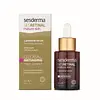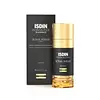What's inside
What's inside
 Key Ingredients
Key Ingredients

 Benefits
Benefits

 Concerns
Concerns

 Ingredients Side-by-side
Ingredients Side-by-side

Water
Skin ConditioningBis-PEG-18 Methyl Ether Dimethyl Silane
EmollientHydrogenated Polydecene
EmollientCeteth-20
CleansingPropanediol
SolventC12-15 Alkyl Benzoate
AntimicrobialCyclopentasiloxane
EmollientGlyceryl Stearate
EmollientGluconolactone
Skin ConditioningAmmonium Acryloyldimethyltaurate/Vp Copolymer
Nicotiana Benthamiana Hexapeptide-40 Sh-Oligopeptide-1
Skin ConditioningNicotiana Benthamiana Hexapeptide-40 Sh-Polypeptide-5
Skin ConditioningNicotiana Benthamiana Sh-Polypeptide-15 Hexapeptide-40
Skin ConditioningAlcohol
AntimicrobialBakuchiol
AntimicrobialBHT
AntioxidantBidens Pilosa Extract
HumectantCarbomer
Emulsion StabilisingCeramide AP
Skin ConditioningCeramide EOP
Skin ConditioningCeramide NP
Skin ConditioningCetearyl Alcohol
EmollientCholesterol
EmollientCopper Sulfate
Skin ConditioningDipotassium Phosphate
BufferingDisodium EDTA
Elaeis Guineensis Oil
EmollientEthylhexylglycerin
Skin ConditioningGlucosamine Hcl
Glycerin
HumectantGlycolic Acid
BufferingGlycyrrhetinic Acid
Skin ConditioningGossypium Herbaceum Seed Oil
Skin ConditioningHydrochloric Acid
BufferingLactic Acid
BufferingLinum Usitatissimum Seed Oil
PerfumingLycium Barbarum Fruit Extract
AstringentMandelic Acid
AntimicrobialNiacin
SmoothingNicotiana Benthamiana Sh-Polypedtide-7
Skin ConditioningParfum
MaskingPhenoxyethanol
PreservativePhosphatidylcholine
EmulsifyingPhytosphingosine
Skin ConditioningPolysorbate 20
EmulsifyingPotassium Phosphate
BufferingPotassium Sorbate
PreservativeRetinal
Skin ConditioningRetinyl Palmitate
Skin ConditioningSodium Benzoate
MaskingSodium Chloride
MaskingSodium Cholate
Skin ConditioningSodium Hyaluronate
HumectantSodium Hydroxide
BufferingSodium Lauroyl Lactylate
EmulsifyingTocopherol
AntioxidantTocopheryl Acetate
AntioxidantTriethanolamine
BufferingTromethamine
BufferingXanthan Gum
EmulsifyingZinc Chloride
AntimicrobialWater, Bis-PEG-18 Methyl Ether Dimethyl Silane, Hydrogenated Polydecene, Ceteth-20, Propanediol, C12-15 Alkyl Benzoate, Cyclopentasiloxane, Glyceryl Stearate, Gluconolactone, Ammonium Acryloyldimethyltaurate/Vp Copolymer, Nicotiana Benthamiana Hexapeptide-40 Sh-Oligopeptide-1, Nicotiana Benthamiana Hexapeptide-40 Sh-Polypeptide-5, Nicotiana Benthamiana Sh-Polypeptide-15 Hexapeptide-40, Alcohol, Bakuchiol, BHT, Bidens Pilosa Extract, Carbomer, Ceramide AP, Ceramide EOP, Ceramide NP, Cetearyl Alcohol, Cholesterol, Copper Sulfate, Dipotassium Phosphate, Disodium EDTA, Elaeis Guineensis Oil, Ethylhexylglycerin, Glucosamine Hcl, Glycerin, Glycolic Acid, Glycyrrhetinic Acid, Gossypium Herbaceum Seed Oil, Hydrochloric Acid, Lactic Acid, Linum Usitatissimum Seed Oil, Lycium Barbarum Fruit Extract, Mandelic Acid, Niacin, Nicotiana Benthamiana Sh-Polypedtide-7, Parfum, Phenoxyethanol, Phosphatidylcholine, Phytosphingosine, Polysorbate 20, Potassium Phosphate, Potassium Sorbate, Retinal, Retinyl Palmitate, Sodium Benzoate, Sodium Chloride, Sodium Cholate, Sodium Hyaluronate, Sodium Hydroxide, Sodium Lauroyl Lactylate, Tocopherol, Tocopheryl Acetate, Triethanolamine, Tromethamine, Xanthan Gum, Zinc Chloride
Water
Skin ConditioningDimethicone
EmollientDibutyl Adipate
EmollientNiacinamide
SmoothingIsoamyl Laurate
EmollientLauryl PEG/PPG-18/18 Methicone
Skin ConditioningGlycerin
HumectantPropanediol
SolventDimethicone/Vinyl Dimethicone Crosspolymer
Skin ConditioningAlcohol Denat.
AntimicrobialBakuchiol
Antimicrobial1,2-Hexanediol
Skin ConditioningPentylene Glycol
Skin ConditioningCaprylic/Capric Triglyceride
MaskingEthylcellulose
Hydroxyacetophenone
AntioxidantPentaerythrityl Tetra-Di-T-Butyl Hydroxyhydrocinnamate
Antioxidant4-T-Butylcyclohexanol
MaskingCaprylyl Glycol
EmollientParfum
MaskingSodium Acrylates Crosspolymer-2
AbsorbentPolyacrylate Crosspolymer-6
Emulsion StabilisingVigna Aconitifolia Seed Extract
Skin ConditioningTocopheryl Acetate
AntioxidantTocopherol
AntioxidantCitric Acid
BufferingXanthan Gum
EmulsifyingMaltodextrin
AbsorbentMelatonin
AntioxidantRetinal
Skin ConditioningSilica
AbrasiveDisodium EDTA
Phospholipids
Skin ConditioningSynthetic Fluorphlogopite
CI 77891
Cosmetic ColorantAscorbic Acid
AntioxidantT-Butyl Alcohol
PerfumingRosmarinus Officinalis Leaf Extract
AntimicrobialPalmitoyl Tetrapeptide-7
Skin ConditioningTin Oxide
AbrasiveChrysin
Skin ConditioningWater, Dimethicone, Dibutyl Adipate, Niacinamide, Isoamyl Laurate, Lauryl PEG/PPG-18/18 Methicone, Glycerin, Propanediol, Dimethicone/Vinyl Dimethicone Crosspolymer, Alcohol Denat., Bakuchiol, 1,2-Hexanediol, Pentylene Glycol, Caprylic/Capric Triglyceride, Ethylcellulose, Hydroxyacetophenone, Pentaerythrityl Tetra-Di-T-Butyl Hydroxyhydrocinnamate, 4-T-Butylcyclohexanol, Caprylyl Glycol, Parfum, Sodium Acrylates Crosspolymer-2, Polyacrylate Crosspolymer-6, Vigna Aconitifolia Seed Extract, Tocopheryl Acetate, Tocopherol, Citric Acid, Xanthan Gum, Maltodextrin, Melatonin, Retinal, Silica, Disodium EDTA, Phospholipids, Synthetic Fluorphlogopite, CI 77891, Ascorbic Acid, T-Butyl Alcohol, Rosmarinus Officinalis Leaf Extract, Palmitoyl Tetrapeptide-7, Tin Oxide, Chrysin
Ingredients Explained
These ingredients are found in both products.
Ingredients higher up in an ingredient list are typically present in a larger amount.
Bakuchiol is a plant-derived antioxidant (it's vegan!). It is often called the replacement for retinol although it is not part of the same family.
It has similar effects as retinol: skin smoothing, reducing discoloration, and preventing wrinkles. It does not cause as much irritation as traditional retinoids.
Bakuchiol works by breaking down free radicals and stimulating collagen production in skin.
Combining bakuchiol with retinol will not have adverse side effects. Studies show using them will just boost the benefits. Bakuchiol is also found to help stabilize retinol.
While bakuchiol does not make the skin more sun sensitive, we recommend wearing SPF on a daily basis.
Read more about traditional retinol
Learn more about BakuchiolDisodium EDTA plays a role in making products more stable by aiding other preservatives.
It is a chelating agent, meaning it neutralizes metal ions that may be found in a product.
Disodium EDTA is a salt of edetic acid and is found to be safe in cosmetic ingredients.
Learn more about Disodium EDTAGlycerin is already naturally found in your skin. It helps moisturize and protect your skin.
A study from 2016 found glycerin to be more effective as a humectant than AHAs and hyaluronic acid.
As a humectant, it helps the skin stay hydrated by pulling moisture to your skin. The low molecular weight of glycerin allows it to pull moisture into the deeper layers of your skin.
Hydrated skin improves your skin barrier; Your skin barrier helps protect against irritants and bacteria.
Glycerin has also been found to have antimicrobial and antiviral properties. Due to these properties, glycerin is often used in wound and burn treatments.
In cosmetics, glycerin is usually derived from plants such as soybean or palm. However, it can also be sourced from animals, such as tallow or animal fat.
This ingredient is organic, colorless, odorless, and non-toxic.
Glycerin is the name for this ingredient in American English. British English uses Glycerol/Glycerine.
Learn more about GlycerinParfum is a catch-all term for an ingredient or more that is used to give a scent to products.
Also called "fragrance", this ingredient can be a blend of hundreds of chemicals or plant oils. This means every product with "fragrance" or "parfum" in the ingredients list is a different mixture.
For instance, Habanolide is a proprietary trade name for a specific aroma chemical. When used as a fragrance ingredient in cosmetics, most aroma chemicals fall under the broad labeling category of “FRAGRANCE” or “PARFUM” according to EU and US regulations.
The term 'parfum' or 'fragrance' is not regulated in many countries. In many cases, it is up to the brand to define this term.
For instance, many brands choose to label themselves as "fragrance-free" because they are not using synthetic fragrances. However, their products may still contain ingredients such as essential oils that are considered a fragrance by INCI standards.
One example is Calendula flower extract. Calendula is an essential oil that still imparts a scent or 'fragrance'.
Depending on the blend, the ingredients in the mixture can cause allergies and sensitivities on the skin. Some ingredients that are known EU allergens include linalool and citronellol.
Parfum can also be used to mask or cover an unpleasant scent.
The bottom line is: not all fragrances/parfum/ingredients are created equally. If you are worried about fragrances, we recommend taking a closer look at an ingredient. And of course, we always recommend speaking with a professional.
Learn more about ParfumPropanediol is an all-star ingredient. It softens, hydrates, and smooths the skin.
It’s often used to:
Propanediol is not likely to cause sensitivity and considered safe to use. It is derived from corn or petroleum with a clear color and no scent.
Learn more about PropanediolRetinal is a form of retinoid. Retinoids are the gold-standard class of anti-aging ingredients.
Retinal has many benefits as other retinoids: improve skin texture, reduce large pores, reduce the effects of aging, reduce the visibility of dark spots, heal scars, and fight acne.
Studies show retinal may work at a faster rate than retinol due to its structure.
All retinoids have to be converted into retinoic acid before starting to work. Some retinoids take several steps of conversion before binding. Retinal is only one step away, making it more potent.
Like other retinoids, retinal may be irritating. It is best to ease into using this ingredient frequently.
Using the 'ramp up' method, start by using retinol once a week. This gives your skin time to adjust and decrease irritation. Once you feel ready, you can slowly increase the frequency of retinol use.
Using retinoids will increase sun-sensitivity in the first few weeks of use. Though studies show retinoids increase your skin's natural SPF with continuous use, it is best to always wear sunscreen and sun-protection.
Learn more about RetinalTocopherol (also known as Vitamin E) is a common antioxidant used to help protect the skin from free-radicals and strengthen the skin barrier. It's also fat soluble - this means our skin is great at absorbing it.
Vitamin E also helps keep your natural skin lipids healthy. Your lipid skin barrier naturally consists of lipids, ceramides, and fatty acids. Vitamin E offers extra protection for your skin’s lipid barrier, keeping your skin healthy and nourished.
Another benefit is a bit of UV protection. Vitamin E helps reduce the damage caused by UVB rays. (It should not replace your sunscreen). Combining it with Vitamin C can decrease sunburned cells and hyperpigmentation after UV exposure.
You might have noticed Vitamin E + C often paired together. This is because it is great at stabilizing Vitamin C. Using the two together helps increase the effectiveness of both ingredients.
There are often claims that Vitamin E can reduce/prevent scarring, but these claims haven't been confirmed by scientific research.
Learn more about TocopherolTocopheryl Acetate is AKA Vitamin E. It is an antioxidant and protects your skin from free radicals. Free radicals damage the skin by breaking down collagen.
One study found using Tocopheryl Acetate with Vitamin C decreased the number of sunburned cells.
Tocopheryl Acetate is commonly found in both skincare and dietary supplements.
Learn more about Tocopheryl AcetateWater. It's the most common cosmetic ingredient of all. You'll usually see it at the top of ingredient lists, meaning that it makes up the largest part of the product.
So why is it so popular? Water most often acts as a solvent - this means that it helps dissolve other ingredients into the formulation.
You'll also recognize water as that liquid we all need to stay alive. If you see this, drink a glass of water. Stay hydrated!
Learn more about WaterXanthan gum is used as a stabilizer and thickener within cosmetic products. It helps give products a sticky, thick feeling - preventing them from being too runny.
On the technical side of things, xanthan gum is a polysaccharide - a combination consisting of multiple sugar molecules bonded together.
Xanthan gum is a pretty common and great ingredient. It is a natural, non-toxic, non-irritating ingredient that is also commonly used in food products.
Learn more about Xanthan Gum